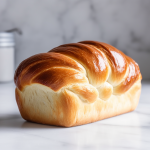Crescent rolls are a delicious, buttery pastry that are similar to croissants but with a few key differences. Both pastries share a flaky, tender texture thanks to layers of dough and butter, but crescent rolls are typically made with a simpler dough and don’t require the lengthy process of laminating dough that croissants do. This makes crescent rolls quicker and easier to prepare while still providing that irresistible soft and flaky bite. They are perfect for breakfast, dinner, or as a side dish for any meal, offering a warm, golden, and slightly sweet flavor that complements a wide variety of dishes.

Crescent Rolls
Ingredients
- 2 cups all-purpose flour
- 1 Tbsp sugar
- 1 tsp fine salt
- 1/2 Tbsp instant yeast
- 1/2 tsp baking powder
- 11 Tbsp butter (room temperature)
- 3/4 cups water (warm)
- Optional: filling for the crescent rolls (chocolate, ham & cheese, etc.)
Instructions
- Combine the flour, sugar, salt, baking powder, and yeast in the bowl of a stand mixer.
- Add water and mix on medium-low speed using the dough hook attachment.
- Add 1 Tbsp of butter at a time, waiting until each piece of butter is fully incorporated into the dough before adding the next.
- Shape the dough into a ball, cover the bowl, and let it rest for 30 minutes.
- Preheat the oven to 375° F.
- Divide the dough into two equal parts.
- Using a rolling pin, roll out each piece into a rectangle over a sheet of parchment paper, approximately the size of a sheet of paper.
- Use a bench scraper to cut vertically into 2 equal parts, then horizontally into 4 equal parts, then 2 more diagonal cuts to make 8 triangle-shaped pieces in total.
- Optional: Add filling to each triangle
- Roll up each triangle piece. Start with the outside edge and roll towards the point in the center.
- Place each roll on a baking sheet with the point facing down so that it doesn’t come undone during baking.
- Bake for 20 minutes, or until golden brown.
Unlike croissants, which are often made with a yeast-based dough and require careful rolling and folding of butter layers, crescent rolls use a dough that’s leavened with yeast and can incorporate a little more sugar, which gives them a softer, sweeter taste. The dough is typically rolled into a thin sheet and then cut into triangles, which are then rolled up into the classic crescent shape. This simplicity in preparation means you can have freshly baked rolls in a fraction of the time compared to croissants, making them a great option for those who want something light and flavorful without the fuss.
While croissants are often reserved for more elegant occasions or special breakfasts, crescent rolls have a more casual appeal, making them a popular choice for weeknight meals, holidays, or even snacks. They can be served alongside soups, salads, or main dishes, and they’re also versatile enough to be filled with cheese, ham, or herbs for a more savory twist. The soft texture of crescent rolls makes them perfect for dipping into soups or sauces, adding an extra layer of satisfaction to your meal.
For an extra touch, crescent rolls can be topped with a glaze of melted butter and sprinkled with a little sea salt before baking, which brings out their buttery richness and adds a subtle savory element. You can also experiment with different flavorings, such as garlic, cheese, or even cinnamon sugar, to make these rolls match the flavor profile of your meal. Their versatility and ease of preparation make crescent rolls an ideal choice for both novice bakers and seasoned pros alike.



